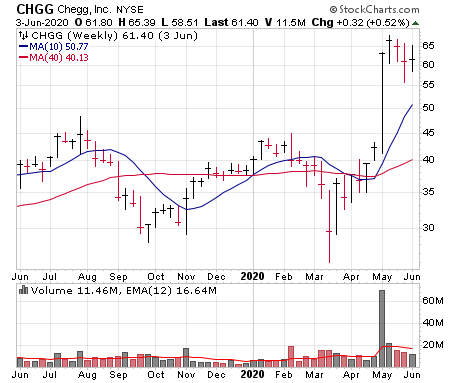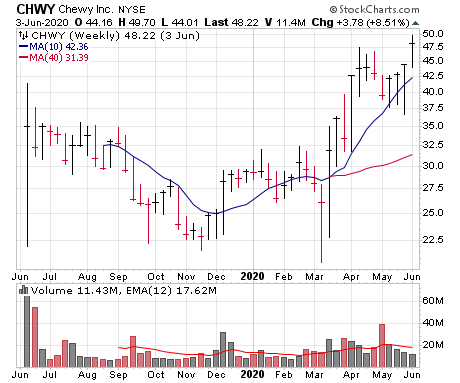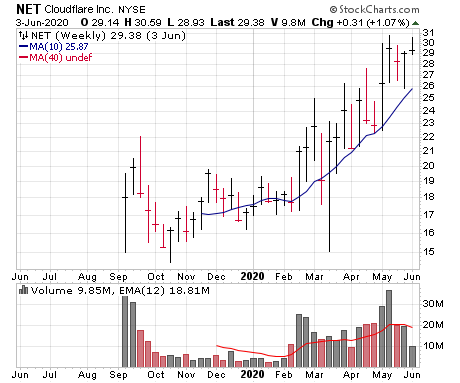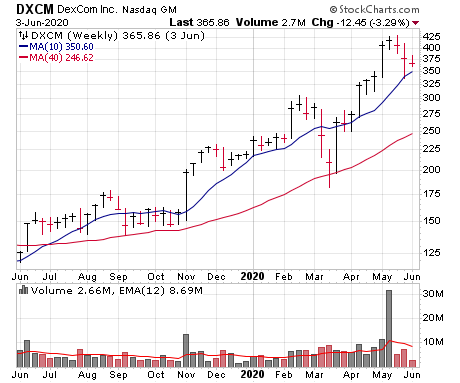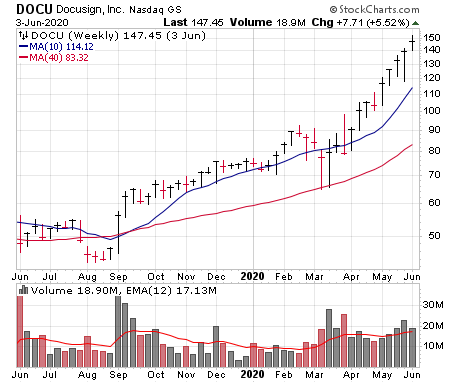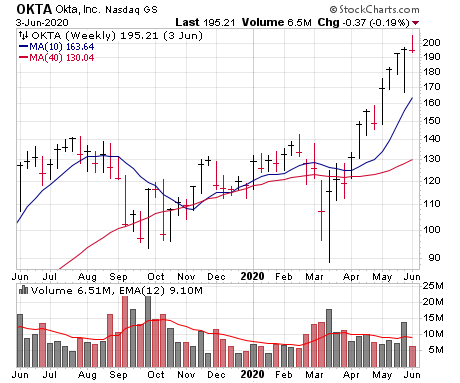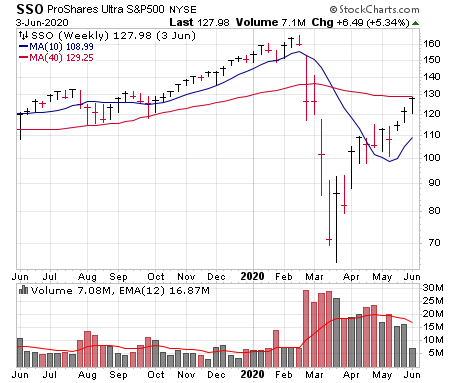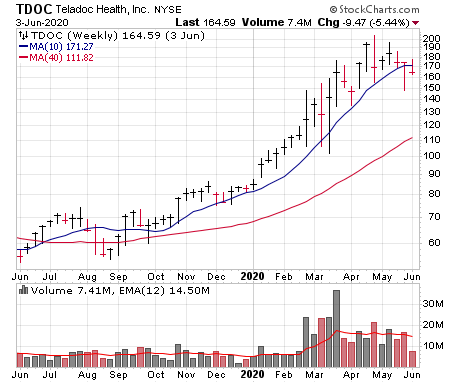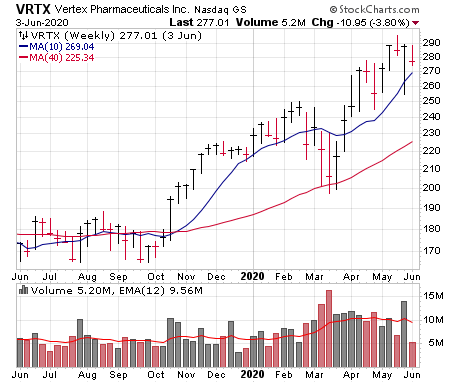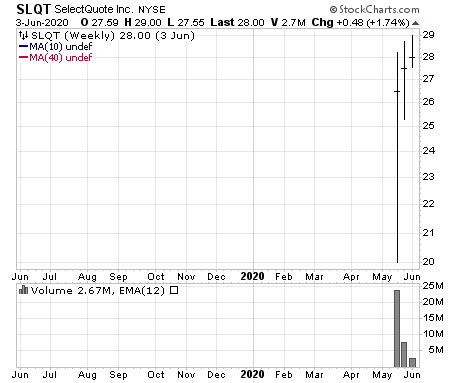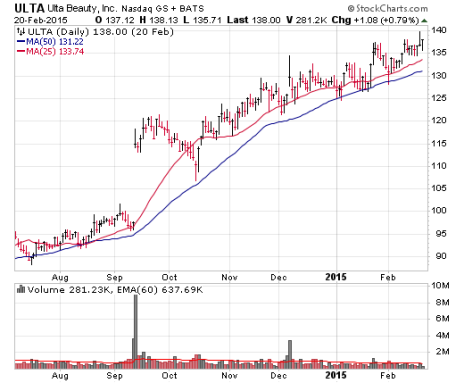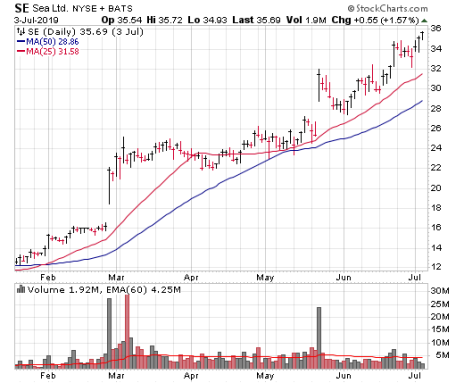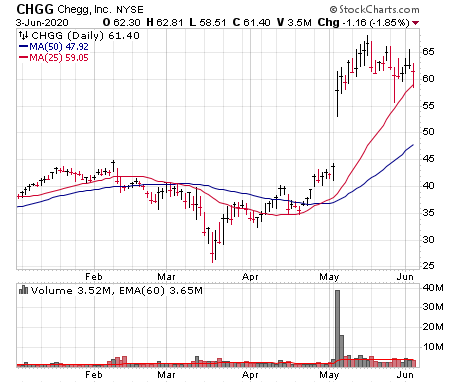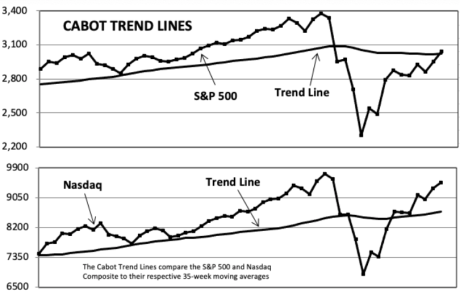The evidence for the overall market continues to improve; over the past week, two blastoff indicators have turned green, which should bode well when looking out over the next few months. Growth stocks, however, remain in a consolidation phase following some huge runs, with many (not all) stocks sagging back during the past week or two. Overall, though, the pullbacks have been normal, so we remain optimistic, though we’re still stepping slowly and looking for decent entry points.
In tonight’s issue, we’re doing a touch more buying, filling out a position in one of our stocks, following the addition of a full position last week. That will leave us with around 18% in cash.
Cabot Growth Investor 1447
[premium_html_toc post_id="206917"]
Believe What You See
Most of the time, the stock market and U.S. economy are in gear—there are always fits and starts, but as the economy expands, earnings generally grow and that contributes to a bull market. But it’s the times when the two are moving in opposite directions that usually throws investors for a loop, and at no time has that been more true than recently.
It’s hard not to be mentally battered and bruised if you take a look around the real world. Tomorrow’s jobs report is likely to see the unemployment rate at Great Depression levels (20%-plus), second-quarter GDP is likely to fall 40%-ish (!) and many industries will never be the same, be it small businesses (a couple sound like they’re toast in my local town) or big (AMC, the theater chain, might not make it out alive).
But in the face of those realities, the market has done the exact opposite of what most expected (including us)—it’s advanced strongly during the past two-plus months, rallying narrowly at first but broadening out during the past couple of weeks. That broadening, in fact, has been so strong that two of the most reliable blastoff indicators we follow (the 90% last week and, just yesterday, the 2-to-1) have recently turned positive!
Thankfully, by staying flexible (one of the key traits of successful investing), we’ve been able to ride much of the move. And the good news is that, for the market as a whole, the evidence has grown increasingly bullish—while there are no sure things, both blastoff measures bode very well for the months ahead, our own Cabot Trend Lines are on the verge of flashing their own buy signal and other measures (dearth of new lows, more bearish individual investors than bullish) are encouraging.
As usual, it’s not all peaches and cream. Growth stocks have been mostly zigging while the broad market zags; just about all of the leaders have taken at least a couple of potshots of late after heady runs in April and early May, including today. That said, while there have been some sharp selloffs, few leaders have broken down, so the odds still favor their next big moves being on the upside.
Stepping back, we’re not losing sight of the fact that, after such a big rally from the March lows, further indigestion, rotation or news-driven action could arrive; it’s more important than ever to focus on the best stocks and hunt for advantageous entry points. But there’s no question the big-picture backdrop is getting brighter, so you should continue to put money to work.
What To Do Now
Remain bullish. In the Model Portfolio, the buy signal from the 90% Blastoff Indicator last week prompted us to buy a stake in the ProShares Ultra S&P 500 Fund (SSO), giving us direct exposure to the overall market. And in tonight’s issue, we’ll fill out our position in Cloudflare (NET), adding another half-sized position, which will leave us with around 18% in cash.
Model Portfolio Update
The market’s rebound has continued since the last issue, though it’s been mostly a broad market affair—growth stocks hit a big pothole last week, staged a big rebound and have suffered another wobble or two this week. Meanwhile, the broad market has steadily picked up steam, causing our 90% Blastoff Indicator to turn green last week and the 2-to-1 Blastoff indicator to speak up yesterday. Of course, that doesn’t mean it’ll be straight up from here; indeed, many growth stocks have seen follow-on wobbles this week, though abnormal selling is still hard to find. But the 90% signal and all the other positive evidence does greatly raise the likelihood that we’re in a new, sustained bull phase that will carry us higher for many months.
Thus, we’re looking to carefully put more money to work, and we’re doing a little of that tonight by filling out our position in Cloudflare (NET). That will leave us with around 18% in cash.
Current Recommendations
| Stock | No. of Shares | Portfolio Weightings | Price Bought | Date Bought | Price on 6/04/20 | Profit | Rating |
| Chegg (CHGG) | 1,216 | 5% | 65 | 5/22/20 | 58 | -10% | Buy a Half |
| Chewy (CHWY) | 1,595 | 5% | 45 | 4/20/20 | 49 | 10% | Hold a Half |
| Cloudflare (NET) | 2,715 | 5% | 26 | 4/20/20 | 28 | 9% | Buy another Half |
| Dexcom (DXCM) | 290 | 7% | 216 | 11/15/19 | 345 | 60% | Hold |
| DocuSign (DOCU) | 982 | 9% | 65 | 9/13/19 | 140 | 115% | Hold |
| Okta (OKTA) | 947 | 12% | 150 | 4/20/20 | 186 | 24% | Buy |
| ProShares Ultra S&P 500 (SSO) | 1,306 | 10% | 120 | 5/29/20 | 127 | 6% | Buy |
| Teladoc (TDOC) | 631 | 7% | 78 | 11/01/19 | 157 | 101% | Hold |
| Twilio (TWLO) | 830 | 11% | 174 | 5/8/20 | 193 | 11% | Buy |
| Vertex Pharmaceuticals (VRTX) | 414 | 8% | 199 | 11/8/19 | 273 | 37% | Buy |
| CASH | $361,755 | 23% |
Chegg (CHGG 58)—CHGG is now two-plus weeks into a normal (albeit a bit scary at times) retreat following its huge earnings gap and run in the first half of May. So far, the action is normal (the stock is just below its 25-day line, which is now near 59.5), and the fact that the stock gapped to new highs on more than 10 times its average volume bodes well. (See more later in this issue on that topic.) Plus, fundamentally, there’s little doubt the firm’s online education platform will see accelerated growth going forward. Of course, there’s no surety in the market, so we’ll adhere to our loss limit (currently in the 53 to 54 area on a closing basis) if our bullishness proves wrong, but given the evidence, we think the next big move will be up. BUY A HALF
.
Chewy (CHWY 49)—The market works to fool the majority, and one way it does that is by having stocks (or indexes) shake below recent support just before embarking on a new run. That looks like what CHWY did last week—it briefly fell to seven-week lows during last week’s maelstrom in growth stocks, but since then it’s exploded straight up to new highs! Normally, we’d be all over this and fill out our position, but the risk here is that Chewy is set to report its quarter next Tuesday (June 8); analysts are looking for sales growth of 38% and a loss of 16 cents per share, but as always, the outlook and sub-metrics (user growth, recurring revenue from Autoship) will be just as important. If you want to roll the dice, we’re not opposed to buying a small position here, but given the upcoming report and the growth stock wobbles, we’ll stay on Hold and see how it goes—a drop back into the 38 range would be a red flag, but a positive reaction (or, really, a non-negative reaction) will probably have us filling out our position. HOLD A HALF.
Cloudflare (NET 28)—Cloudflare doesn’t get a lot of publicity, but that hasn’t stopped some sharp mutual funds from grabbing shares; in fact, a collection of Fidelity funds have snapped up 23.2 million shares, or about 7.5% of the company as a whole. Granted, as of March, less than 200 funds owned this recent IPO, but we think a lot more will be building positions for a simple reason—the firm’s global cloud platform is likely to crank out steady, predictable growth for a long time to come as businesses of all sizes rely on it for network services. The stock can be quite wiggly, but it continues to stair-step higher, and we have a modest profit on our initial stake (bought back in mid-April). We’ll fill out our position here, buying another half-sized position (5% of the portfolio); our loss limit on the total position will be in the 24 area. BUY ANOTHER HALF.
Dexcom (DXCM 345)—Dexcom was hit hard last week, which wasn’t totally unexpected after the stock’s crazy run in the short-term (280 to 425 after breaking out in early April) and intermediate-term (up from its original breakout near 180 last November), as well as other factors (convertible bond offering, etc.). And, while it bounced initially, shares have sagged back toward last week’s lows and the 50-day line (which is now at 336 and rising). We certainly don’t think anything has changed with the underlying story, though it’s worth nothing that analysts see earnings up just 14% this year due to a virus-related slowdown (fewer people going to the doctor in Q2 and possibly the rest of the year as well), which could be something to watch. If you bought at higher prices, a stop just below that 50-day line probably makes sense, but given that we’ve already sold half our original shares and have a big profit on the rest (and that the stock has unlikely hit its ultimate ceiling), we’re going to give our remaining position plenty of rope (probably into the 290s). HOLD.
DocuSign (DOCU 140)—As opposed to Dexcom, DOCU has continued its amazing run (before today) even after our partial sale from a couple of weeks ago, soaring to new highs near 150 on huge volume. We’re certainly not complaining, though the stock is now even more extended (the 50-day line is down around 110) and the company is set to report earnings tonight—analysts are looking for sales of $281 million and earnings of 10 cents per share. Having already sold half our original shares, we’re willing to give what we have left of DOCU plenty of room to maneuver, so barring a complete earnings meltdown (20%-plus sort of thing), we’re not likely to sell. That said, the stock isn’t near a solid entry point, either. Long story short, let’s just see how the stock reacts to earnings and re-evaluate after that. HOLD.
Okta (OKTA 186)—OKTA had a deep shakeout to its 25-day line last week (that line is now near 178), but it snapped back to new highs following another great earnings report—in the quarter that ended in April, the company’s revenues grew 46% (6% above expectations) and remaining performance obligations (everything under contract) leapt 57%, and while accounting earnings remain in the red, free cash flow is surging (not uncommon in subscription-heavy businesses), coming in at nearly $30 million (or a whopping 16% of revenues). And, as usual, the sub-metrics (customer count up 28%, same-customer growth rate of 21%) also pleased. It also doesn’t hurt that two new-age cybersecurity peers (Zscaler and CrowdStrike) have reported fine results over the past week, too. To be fair, the company did keep guidance the same despite beating estimates to account for potential virus-related customer churn, but that’s mostly nibbling around the edges; Okta announced new or expanded deals with big boys like FedEx, Moody’s, Workday, Zoom, T-Mobile and the state of Illinois. Like many market leaders, OKTA has suffered a second wave of selling this week, and it’s extended to the upside. Thus, we advise buying on dips of a few points, but given that it just got going from a multi-month consolidation, pullbacks should be contained unless growth stocks really get taken to the woodshed. BUY.
ProShares Ultra S&P 500 Fund (SSO 127)—The 90% Blastoff Indicator’s buy signal prompted us to go back into SSO last week, adding a full (10%) position to the portfolio. And, of course, yesterday’s 2-to-1 buy signal only adds fuel to the case for a sustained uptrend. We’re not ETF investors, but owning a leveraged long fund of a major index gives us a good foothold in what the odds now favor being a sustained uptrend in the months ahead (with the usual potholes, of course). If you want to stick with non-leveraged index funds (SPY in this case) or dabble in a different index, that’s up to you (though we’d avoid triple-leverage funds and aggressive sector funds that might diverge from the overall bull market). However, we went with SSO because (a) the studies done on our blastoff indicators usually involve the S&P 500, and (b) the S&P provides us some exposure to the non-growth areas of the market (about half the index is outside of technology, health care or communications), while we already have a lot of growth-oriented titles. Pullbacks will occur, of course, but we think you can buy SSO here. BUY.
Teladoc (TDOC 157)—Like most growth stocks, TDOC suffered a sharp dip last week (low near 148), bounced well, and is now seeing some follow-on selling, though it remains well above last week’s low. Taking a step back, the stock is now in its sixth week of correcting and consolidating (maximum retreat of 27%) following a massive run in the first four months of 2020; we think there’s a good chance this becomes the pause that refreshes the overall uptrend, especially as just about every piece of fundamental data points toward huge growth coming down the road for the firm’s telemedicine services. That said, we’re just going to play it by the book—if the stock does dive below our mental stop (low/mid 140s), we’ll probably take the rest of our profit and move on, but above there, we want to give shares a chance to scare/wear out some more weak hands and resume the overall uptrend. If you own some, hang on. HOLD.
Twilio (TWLO 193)—Short-term, TWLO could take a rest at any time; in fact, its recovery from last week’s growth stock dip has been just OK (low-volume buying, etc.), so some further stumbles (like we saw today) would be normal. But overall, this continues to have the look of one of the flagbearers of this bull market, so we see any dips as buyable. The company made some news two weeks ago when it said it will power the communications (via its Flex cloud-based contact center solution) for New York City’s contact tracing efforts in relation to the virus. Bigger picture, just 15% to 20% of current contact centers use the cloud today, highlighting the growth potential of Twilio’s solution. BUY.
Vertex Pharmaceuticals (VRTX 273)—VRTX rebounded well from the test of its 50-day line last week, but at the same time, shares aren’t much higher now than they were in mid-April—that’s not bad by any stretch, though in fairness, it’s not as peppy as many leading growth stocks out there. If shares struggle for another couple of weeks, we could go to Hold and focus new buying elsewhere, but at this point, there could be a good chance VRTX is playing possum; the growth story is as good and as predictable as ever, and earnings estimates continue to creep up ($8.91 per share this year, up a dime from a couple of weeks ago). We’re keeping our eyes peeled, but right here, we think new buyers can still grab a position. BUY.
Watch List
- Coupa Software (COUP 224): COUP looks to have established itself as the strongest cloud software name, which goes along with its best-in-class story. Earnings are due out next Monday (June 8).
- Datadog (DDOG 73): After a massive run, DDOG has rested for three weeks, and another dip (maybe to the 25-day line, now near 63) could be buyable. Its application and infrastructure performance monitoring solutions should be in huge demand for a long time to come.
- Inphi (IPHI 120): IPHI remains in great shape, partly because it’s one of the most straightforward plays on the demand for faster networks. The trick here is finding an entry point, which may take a bit longer.
- Peloton (PTON 48): We remain very high on PTON, which has snapped back very well from last week’s shakeout. It’s a wild child but a little more time in its consolidation could do the trick.
- Wingstop (WING 122): WING continues to act great, and while it’s unlikely to be a “hot” growth stock, we think the firm’s excellent cookie-cutter story (along with its top-notch digital ordering platform) should push it nicely higher over time.
Other Stocks of Interest
Beyond Meat (BYND 134)—I admit I won’t be going vegetarian or vegan anytime soon (I’ll take a NY Strip medium anytime), but it’s a fact that the movement to healthier foods is firmly in place, and Beyond Meat is a leader in the next iteration of that long-term trend. The company is one of the big players in the “alternative meat” movement, as it takes non-meat products (the burgers are pea-based but there’s a bunch of stuff in them) to replicate the taste, feel and look (it even “bleeds” like a burger!) of a hamburger. (The firm actually spends 7% of revenues on R&D, resulting in a wave of new and improved products.) The taste is pretty good (we’ve tried them), far better than the old veggie burgers that used to be peddled, and Beyond’s products (also including ground beef and sausage) are sold in 60,000 retail locations worldwide and 34,000 foodservice locations in the U.S. alone (including Dunkin Donuts, TGI Friday’s and Carl’s Jr.). And their popularity is exploding—sales have been growing at triple-digit rates, and that continued in Q1 (total revenues up 141%), with U.S. retail, U.S. foodservice and international sales all more than doubling from the year before. The company has also turned profitable and analysts see the bottom line picking up meaningfully in the quarters to come. Yes, the current “regular” meat shortage has helped business, but this is far more than a virus story—as we wrote above, the overall trend is in place and given that U.S. meat sales total $270 billion annually, Beyond ($355 million in sales during the past 12 months) is just scratching the surface. The stock had a monstrous post-IPO run and then an even larger post-IPO droop. But the action from the January high looks like a four-month launching pad with massive-volume buying in early May (before and after earnings) and a nice, relatively tight consolidation during the past three weeks. We’re intrigued.
PayPal (PYPL 157)—PayPal needs no introduction—it’s one of (if not the) leader in online payments and money transfers, and it’s a name we made good money on in 2017-2018 as it embarked on its initial post-IPO run. And after a nine-plus month rest/shakeout, its next big advance is underway. The story hasn’t changed all that much: It’s basically the next MasterCard or Visa, with 325 million active accounts (including 25 million merchants) that use it to pay more safely and securely online, while the firm’s Venmo money-transfer offering is the leader in that emerging field. Sales, earnings and free cash flow have been growing steadily for years, and now it appears that growth is set to accelerate—while Q1 results were solid (revenue up 13%, transactions per account up 7% from a year ago and 19% growth in payment volumes), the real excitement has come in recent weeks, as business has gone wild. In April, new sign-ups were more than double that of a year earlier (averaging 250,000 new accounts per day!) while revenues and payment volume accelerated, and in a recent interview, the firm’s CEO said usage among all accounts is up 20%, while those new accounts are 30% more active than the usual new user! Exact numbers aside, PayPal is clearly enjoying a boom as e-commerce use accelerates, which means business should pick up meaningfully. As for the stock, it’s stormed back from its March lows, breaking out to new highs after earnings and rising eight weeks in a row, a clear sign of institutional demand. It’s likely to be the fastest, sexiest horse out there, but the fundamentals and the chart tell us PYPL should be nicely higher when looking out a few months. Pullbacks would be tempting.
SelectQuote (SLQT 28)—SelectQuote is a (very) new issue, so it’s too soon for us to dive in, but we’re keeping an eye on it because of it has a great, straightforward growth story that should attract many big fish if all goes well. The company has been around for 30 years and is now one of the leading online insurance brokers; it doesn’t insure anyone (no underwriting risk), but simply connects hundreds of insurance firms with qualified leads it generates through a variety of internet channels, making commissions along the way. (More than half of revenue is for senior-oriented plans like Medicare Supplement and Medicare Advantage, with about one-third from life insurance, the rest auto and home.) But SelectQuote is far more than just another online portal—both via technology (it ranks every lead one to 10 based on a variety of factors) and via personnel (more than 1,000 agents that are specialized in certain insurance fields), it gets more and better leads than most of its competition. As the industry moves online, SelectQuote is in perfect position to garner more and more business, and that’s exactly what’s been going on in recent years: Sales lifted 44% last year and earnings came in at 44 cents per share (pretax profit margin of 28%!), and there’s no reason that can’t continue for a long time to come. Customer concentration is an issue (three carriers are responsible for 60% of revenue!), but that’s pretty much true with anything involving the insurance industry. There’s not much to analyze on the chart, but this is the kind of long-term growth story that should attract a lot of big investors.
Blastoff Indicators Now in Effect
Eighty-plus percent of our system is based on what we call rubber-meets-the-road evidence—specifically, the trend of the major indexes and action of leading growth titles. Additionally, though, when the market is coming out of a major decline (either a short crash or a more prolonged bear phase), it’s reassuring to get one of our key Blastoff indicators to turn green, which puts the odds dramatically in the bulls’ favor.
To review, these Blastoff measures all reveal a similar environment—a market that has developed a ton of internal upside momentum, which, when combined with the prior selling, means investor perception has gone from very negative to very positive in a (relatively) brief period of time. While these indicators flash when the market is “hyper-overbought,” they almost always lead to even higher prices for the market in the months down the road.
The two most reliable of these measures in our opinion are the 2-to-1 Blastoff Indicator (occurs when the 10-day Advance-Decline Line averages 2-to-1 over a 10-day span) and the 90% Blastoff Indicator (when 90% of NYSE stocks close above their 50-day lines for the first time in a while). One of the flies in the ointment of the current rally was the lack of either of these two flashing, partly because of the divergent environment that was in effect. But that changed last week when the 90% signal turned green, and the 2-to-1 Blastoff Indicator had its own buy signal yesterday (June 3).
(Full disclosure: We first read about the 90% indicator in The Chartist many years ago, so credit to Dan Sullivan, Steve Mais and their team. The 2-to-1 measure was invented by ace technician Walter Deemer in the 1970s; you can follow him @WalterDeemer on Twitter.)
Starting with the 90% indicator, seeing that many NYSE stocks above their 50-day lines (it nearly got to 90% on the Nasdaq, too!) gives you the impression that the market has come too far, too fast and is ready for a pullback. But, historically, that impression would be wrong! Before this year, there have been 12 signals since 1970—during the next three months, the average maximum gain in the S&P 500 was 8.8%; during the next six months, the average max gain was 12.5%; and over the following year, it was 19.4%. Note, too, that the Nasdaq (and growth stocks) often outperform the S&P in these uptrends.
Just as impressive as the gains is that the signals rarely have led to meaningful losses—if you bought the S&P on the day of the 90% signal, the average maximum loss was less than 2%, with the worst (-4.8%) occurring in 2016, when Brexit briefly knocked the market for a loop that July.
The 2-to-1 Blastoff Indicator, which has flashed just 11 other times since 1962, has a slightly more lucrative history: Three months later, the S&P 500’s maximum rally has averaged 11.4%, while that figure rises to 15.8% six months out and nearly 23% a year out. Drawdowns have been slightly worse on average, but the risk/reward ratio looking out six months to a year has been outstanding.
Now, with all of that said, we’re talking about just two indicators—there are never any sure things in the market, and given that 2020 has been as unusual a year as we can remember (both in the market and in the real world), it’s always possible this year’s 90% and 2-to-1 signals could eventually be overwhelmed by other factors.
But investing is all about odds, and some of the most bullish odds occur when a major blastoff indicator (or two) flashes after an earth-shattering decline. That’s just the situation we have today when it comes to the major indexes.
10x Volume Breakout: A Key Bullish Factor to Watch For
As opposed to the market as a whole, we’re not big fans of traditional indicators—if you get value from MACD, RSI, Bollinger Bands and the like, that’s great, but we’ve found most of them lacking over the years.
However, there are many easy-to-spot chart clues that can give you a heads up that something special could be getting underway. One of those clues is when a stock soars to new highs (usually on earnings or a piece of perception-changing news) on more than 10 times its average volume—assuming the stock is somewhat liquid and has a good story, this move can often kick off a powerful intermediate- to longer-term advance.
For example, in 2014, this is how we spotted Ulta Beauty (ULTA), which was a great cookie cutter story as it took share in the beauty products industry. After a big slide during the prior year, the stock gapped up in September on more than 10 times average volume. We bought the stock a few weeks later and it steadily marched its way to north of 300 in early 2017 before cracking.
Last year, in 2019, there was Sea Ltd. (SE), which broke out in late February after earnings. Interestingly, the stock went mostly sideways for a couple of months, but it’s now nearly quadrupled from that original breakout.
This year, we think Chegg (CHGG) may follow the pattern—the stock basically consolidated for 15 months before its early-May quarterly report caused a stampede of buying that kicked the stock out of its base on more than 10 times average volume. After a brief upside follow-through, shares have pulled back, and as always, we’ll cut our loss if the nascent move ends up failing. But given the power on the breakout, the odds strongly favor Chegg being near the beginning of a sustained upmove. BUY A HALF.
Cabot Market Timing Indicators
The evidence has been mostly positive for a few weeks now, and it continues to improve—the 90% Blastoff signal last week and 2-to-1 Blastoff signal yesterday bodes well for the months to come. Plus, our Cabot Trend Lines are on the verge of a green light, too! Bottom line: We remain optimistic the path of least resistance remains up.
Cabot Trend Lines: On the Fence
Our Cabot Trend Lines have improved to the point where they’re now on the fence—at the end of last week, both the S&P 500 (by a slim 0.8%) and the Nasdaq (by a big 9.6%) closed above their respective 35-week lines, and if both indexes repeat that trick at tomorrow’s close (S&P above 3,025, Nasdaq above 8,700) the Trend Lines will turn positive! That said, we don’t anticipate signals, so we’ll see how things finish up at week’s end.
Cabot Tides: Bullish
Thanks in part to a pickup in the broad market during the past three weeks, our Cabot Tides remain solidly positive, with all five of the indexes we track (including the S&P 600 SmallCap, shown here), nicely above their lower (50-day), rising moving averages. Even better, the indexes have plenty of daylight, so a short-term rest or shakeout shouldn’t crack the uptrend.
Cabot Real Money Index: Positive
Despite the generally rising market, our Real Money Index remains in positive territory—in fact, money has flowed out of equity funds and ETFs each of the past five weeks! That doesn’t really tell you much about the very near-term, but big picture, it’s clear investors aren’t stampeding back into stocks, which is a good overall sign.
Charts courtesy of StockCharts.com
The next Cabot Growth Investor issue will be published on June 18, 2020.
Cabot Wealth Network
Publishing independent investment advice since 1970.
CEO & Chief Investment Strategist: Timothy Lutts
President & Publisher: Ed Coburn
176 North Street, PO Box 2049, Salem, MA 01970 USA
800-326-8826 | support@cabotwealth.com | CabotWealth.com
Copyright © 2020. All rights reserved. Copying or electronic transmission of this information is a violation of copyright law. For the protection of our subscribers, copyright violations will result in immediate termination of all subscriptions without refund. No Conflicts: Cabot Wealth Network exists to serve you, our readers. We derive 100% of our revenue, or close to it, from selling subscriptions to its publications. Neither Cabot Wealth Network nor our employees are compensated in any way by the companies whose stocks we recommend or providers of associated financial services. Disclaimer: Sources of information are believed to be reliable but they are not guaranteed to be complete or error-free. Recommendations, opinions or suggestions are given with the understanding that subscribers acting on information assume all risks involved. Buy/Sell Recommendations: All recommendations are made in regular issues or email alerts or updates and posted on the private subscriber web page. Performance: The performance of this portfolio is determined using the midpoint of the high and low on the day following the recommendation. Cabot’s policy is to sell any stock that shows a loss of 20% in a bull market or 15% in a bear market from the original purchase price, calculated using the current closing price. Subscribers should apply loss limits based on their own personal purchase prices.

